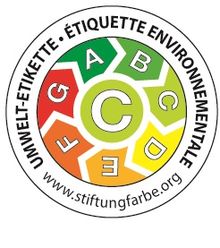Environmental etiquette
The environmental label is a voluntary environmental label for coating products launched by the Swiss Color Foundation . The label divides the various color products into seven categories according to their environmental impact and usability .
aims
The environmental label divides wall paints, varnishes, wood and floor coatings and paste-like plasters and fillers indoors, as well as facade paints into seven different categories from A to G according to their environmental compatibility and usability. Category A places the highest demands on a product. With the environmental label I, categories A to E are reserved for water-soluble products, while solvent-based paints are labeled with categories F or G. With the environmental label II, categories A to E are reserved for products free from film protection agents. The aim of the environmental label is to be a widely accepted and easily understandable Swiss environmental label for paints . The majority of the coating materials sold in Switzerland should be labeled with it. The environmental label is a voluntary and industry-financed environmental label. With the end of the transition period on December 31, 2013, the participating paint manufacturers are obliged to declare all of their interior wall and ceiling paints. The principle of self-declaration applies. The correct classification of the products is monitored by the Technical Commission of the Swiss Color Foundation and spot checks are carried out on a regular basis.
criteria
The following criteria are taken into account when certifying the environmental label I interior wall paints:
- Dilutable (water or solvent dilutable)
- free of aromatics
- label-free (according to Swiss Chemicals Act )
- free of film protection agents
- low in volatile organic substances ( VOC )
- free of volatile and non-volatile organic substances ( VOC and SVOC )
- free from allergenic , highly environmentally hazardous and CMR substances
- Consisting of more than 95 percent from renewable raw materials
- Usability ( wet abrasion resistance and contrast ratio)
The following criteria are taken into account when certifying the environmental label II paints, wood and floor coatings inside:
- Dilutable (water or solvent dilutable)
- free of aromatics
- label-free (according to Swiss Chemicals Act )
- free of film protection agents
- low in volatile organic substances ( VOC )
- free of volatile and non-volatile organic substances ( VOC and SVOC )
- free from allergenic , highly environmentally hazardous and CMR substances
- Consisting of more than 95 percent from renewable raw materials
- Usability (adhesive strength, adhesive tensile strength, wear resistance, abrasion resistance, fire behavior)
The following criteria are taken into account for the certification of the environmental label III paste-like plasters and fillers inside:
- Dilutable (water or solvent dilutable)
- free of aromatics
- label-free (according to Swiss Chemicals Act )
- free of film protection agents
- low in volatile organic substances ( VOC )
- free of volatile and non-volatile organic substances ( VOC and SVOC )
- free from allergenic , highly environmentally hazardous and CMR substances
- Consisting of more than 95 percent from renewable raw materials
- Usability
The following criteria are taken into account for the certification of the environmental label IV facade paints:
- Dilutable (water or solvent dilutable)
- free of aromatics
- low in volatile organic substances ( VOC )
- label-free (according to Swiss Chemicals Act )
- free from allergenic , highly environmentally hazardous and CMR substances
- free of film protection agents
- Environmental pollution from film protection agents
- Consisting of more than 95 percent from renewable raw materials
- Claiming the technical properties
Sponsorship
The environmental label is awarded by the Swiss Color Foundation. The superordinate body of the foundation is the foundation council . The Technical Commission ensures the correct classification of the products and the further technical development of the environmental label.
Individual evidence
- ↑ a b c d Swiss Foundation Color: Regulations , accessed on March 27, 2017.




